
Beatles Different Record Labels
Developed by Serge Pelletier with help from Piers Hemmingsen and Fred Young
33 RPM Albums
Black Rainbow
The first label variation on which Beatles records were pressed was the classic black label with a rainbow color band. This variation of the Black Rainbow label was first issued in the early sixties (T-6018) and has a glossy label. The perimeter print shows the word CANADA without brackets. This label variation was kept until 1966 where Capitol Records of Canada was re-incorporated to Capitol Records (Canada). Labels then had the CANADA in brackets, making it easier to differentiate early sixties pressings from late sixties repressings. This label was used for Beatles records until 1968 where they switched to their own label called Apple Reords.
Two plants pressed Beatles records, the indentation ring found on the labels allows us to easily identify which plant pressed a record. RCA had a deep circular groove etched in the label as Compo only had a small ring around the spindle hole.
Some occasional records have a ring resembling a Columbia pressing in some way. These marks are in fact "faulty" RCA pressing rings due to human factors in the pressing process, or to temporary pressing equipment used sporadically.

Early sixties RCA pressing without brackets on the left, its COMPO counterpart in the center and the different faulty RCA pressing on the right.
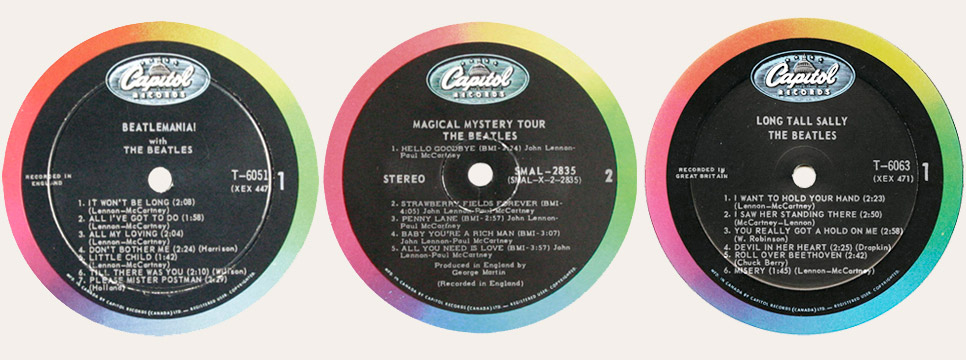
Late sixties RCA pressing WITH brackets on the left, its COMPO counterpart in the center and and the different faulty RCA pressing on the right.
United Artists
When the The Beatles released A Hard Day's Night in North America in 1964, they had a deal with United Artists for the distribution of the soundtrack. Canada had slightly different labels than its US counterpart. All mono albums were issued on the red and silver label as for stereo albums were pressed with black and silver labels. Although, the demand being so high, United Artsits most likely ran out of red labels and used other colored labels for their mono album; black (same as stereo) and blue. They were all pressed at the COrnwall Compo Plant. Although the cover states it was made in Lachine, operations had already moved to Cornwall.
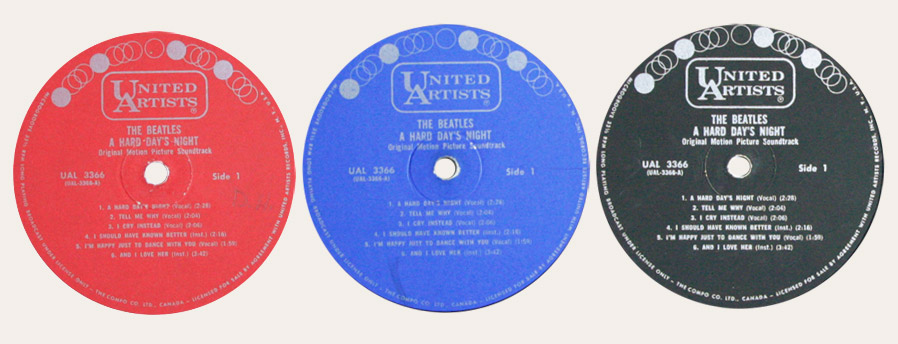
Compo pressings on the regular red label used for MONO records, followed by blue and black labels used when UA was out of red labels due to high demand.
Later reissues in Canada saw the album on the tan label and the sunrise label before being turned over to the Capitol purple label. No "orange and pink" or "black and orange" UA labels were used in Canada.
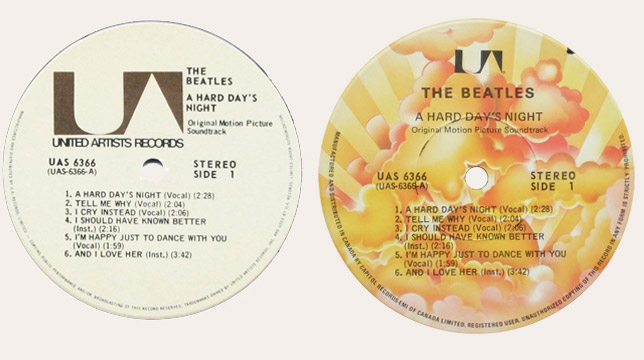
Some UA Beatles albums were pressed by MCA and Capitol. This sunrise label is a Capitol pressing from circa 1978.
Apple
In 1968, The Beatles started their own record label called Apple Records. While still distributed by Capitol, they created their own design which showed a green apple on one side, and a sliced apple on the other side. Canadian labels are glossy with a dark green background and had "MFD by Apple Records inc" on the sliced side of the label. There are no variations with different permimeter prints on Canadian pressings, but labels between 1973 and 1975 had a flat finish and were pressed by Columbia. Also, no pre-Apple albums were reisued on the Apple label, as it was the case in the USA; instead, Capitol of Canada reissued them on the red target label. The Apple label was used for Apple releases until 1975, where the albums were transfered to the current Capitol label (orange label). The Red and Blue albums had a certain custom version of the label, see CUSTOM entry below for details.
Apple Records was revived in the 90s to issue the new Beatles albums, but no vinyl was pressed on Apple in Canada; they only produced CDs and imported the vinyl from the UK.

RCA pressing on the left, Compo Pressing in the middle, flip side on the right.
Green Target
In 1969, Capitol changed their logo to the round target logo; they also created a new target label design for the occasion. This label was lime green and was used until 1971 where it was then replaced by the similar red target label. All the Capitol Beatles albums were reissued on this label, except for The Beatles Story and the three 6000 series albums.
Note that this Yesterday and Today pressing is stereo but bears a MONO catalog number. This mistake also happened on the orange label for this album. These were exceptionally pressed by Keel, maybe as a test for a possible subcontracting contract.
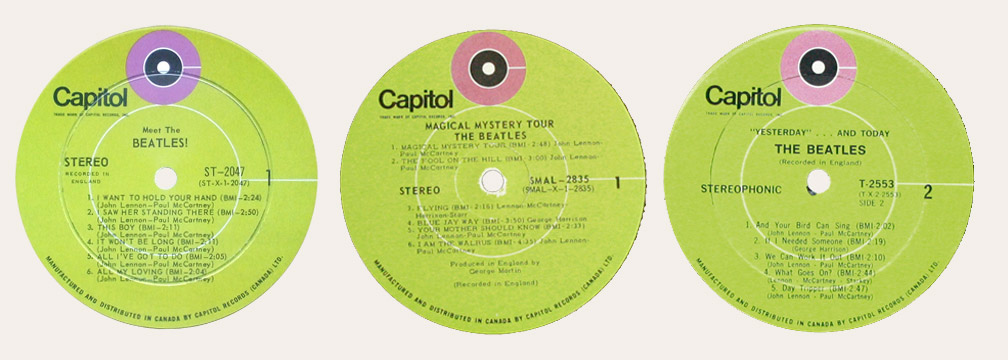
On the left is an RCA pressing, a Compo Pressing in the centre, and on the right: the scarce Keel pressing.
Red Target
In 1971, Capitol changed to the red target label. It is identical to the original lime green label, but with different colors. All the Capitol Beatles albums were reissued on this label, INCLUDING The Beatles Story and the three 6000 series albums, but no Apple album. This label is quite rarely found on Beatles albums in the USA, but is, on the contrary, quite common in Canada.
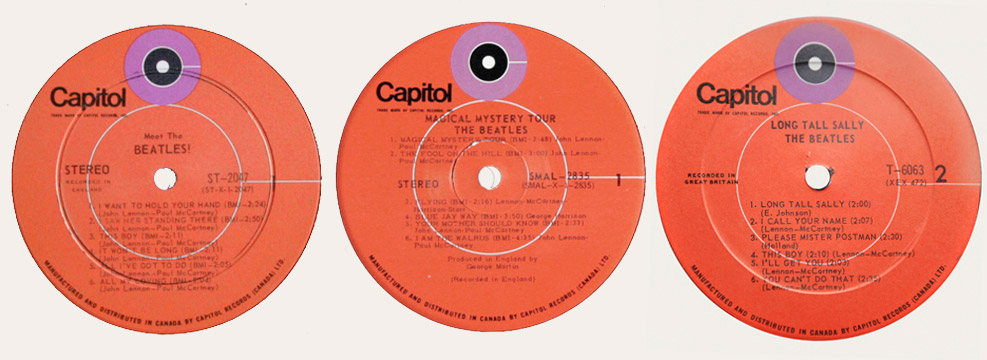
RCA pressing on the left, Compo pressing in the centre and the "faulty" RCA pressing on the right.
Orange
In 1972, Capitol changed labels again and this time opted for the orange label. The first generation had a "gold-ish" tint perimeter print that states "Capitol Records (Canada)".

First generation labels: Here on the left is the RCA pressing, Second label is Compo and the third is a Columbia / CBS pressing.
In 1974, capitol changed for very similar orange labels but had a black perimeter print that stated "Capitol Records - EMI" instead, creating the second generation of orange labels. RCA most likely did not print any albums from then on and transfered their jobs to CBS / Columbia and Compo.

Second generation labels: Here on the left is an odd RCA pressing (Compo and Columbia had the contracts for 2nd generation labels). Second label is Compo and the third is a Columbia / CBS pressing.
A "third" generation of orange labels from 1976 also exists, and was pressed by Capitol's new pressing facilities before switching over to the purple label. We can see the new Capitol size ring on the label. Possibly, Capitol used up old orange labels to test their new home pressings before switching to the new purple label, but this would need to be confirmed. Source: Gilles Valiquette.
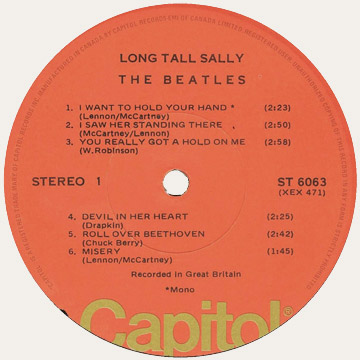
The orange label offered stereo versions of the three 6000 series albums for the first time. All Beatles Capitol and Apple albums were issued on this label, from Beatlemania to Let It Be, except for Yellow Submarine.
Purple
In 1977, Capitol reverted to a retro look with the comeback of the purple label, featuring once again the old Capitol building logo on the label. This label is similar to the first purple 78 rpm labels. Every Beatles album up to 1983 was issued on this label, all in stereo; making mono pressings of the first 3 albums now unavailable.
Once again, three generations of purple labels exist. The first generation is from 1977 and is very similar to US pressings and was made during the transition periode of the new Canadian Capitol pressing plant. This 1st generation is quite scarce as only a small quantity of pressings were made. It is easily recognizable by the Capitol logo in the perimeter print and its darker purple background.
The second generation from 1978 is Canadian made and has a softer purple background with no Capitol logo in the perimeter print. The print states "Manufactured in Canada By Capitol Records".
Finally, the third generation from 1980 is quite common and actually very similar to the previous 1978 version, but the perimeter print is different as it states "Manufactured in Canada UNDER LICENSE by Capitol Records".
Capitol now owned their own pressing plant so all home-made pressing feature a medium sized ring on the label.

first generation purple label with the logo in the perimeter print on the left, the second generation in the center and the third "under license" generation on the right.
Green Budget
Around the same period, Capitol created the green budget series label; identical to the purple label, but green, intended for low priced albums. The only Beatles albums to be issued on this label were the 2 separate volumes of the Rock'n'Roll Music reissue.
These labels were used by both Columbia and RCA on their Dynaflex pressings.
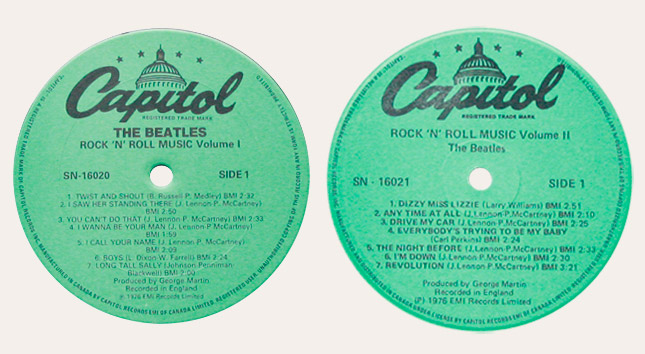
Columbia ring on the left, and Dynaflex pressing on the right
Retro Rainbow
In 1980, Capitol returned yet again to an older label type, bringing back the Black Rainbow label. This time the labels had a matte finish, and featured a white perimeter print on the black part of the label. The text on the label is also white instead of the old silver print over the black label. Rarities and Beatles Ballads used this "new" label in 1980, but the new design was actually only introduced officially in 1983. All Beatles albums were reissued on this label, except for The Early Beatles (to be confirmed), Rock'n'Roll Music, Love Songs and Reel Music. in 1987, Capitol reissued the UK albums on the retro rainbow, these had a Parlophone logo added to the label.
Capitol still operated their pressing facilities, so some early pressings feature a medium sized ring on the label, while others have a large Columbia ring. Some rare 1983 pressings were also made by Cinram.
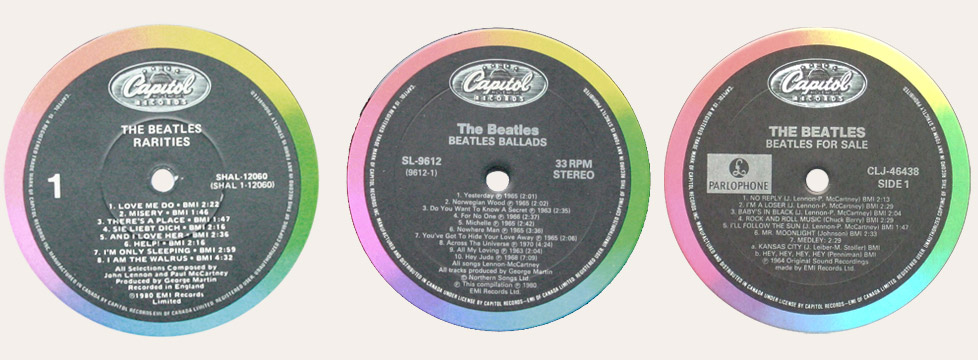
Retro Rainbow with mid-sized ring on the left, with large ring in th middle and with the added Parlophone logo on the right.
Custom
Some albums featured special custom labels made specifically for the album. They were all issued in the late 70s and early 80s. Albums with custom labels were: Rock'n'Roll Music, Live At The Hollywood Bowl, Love Songs and Reel Music.
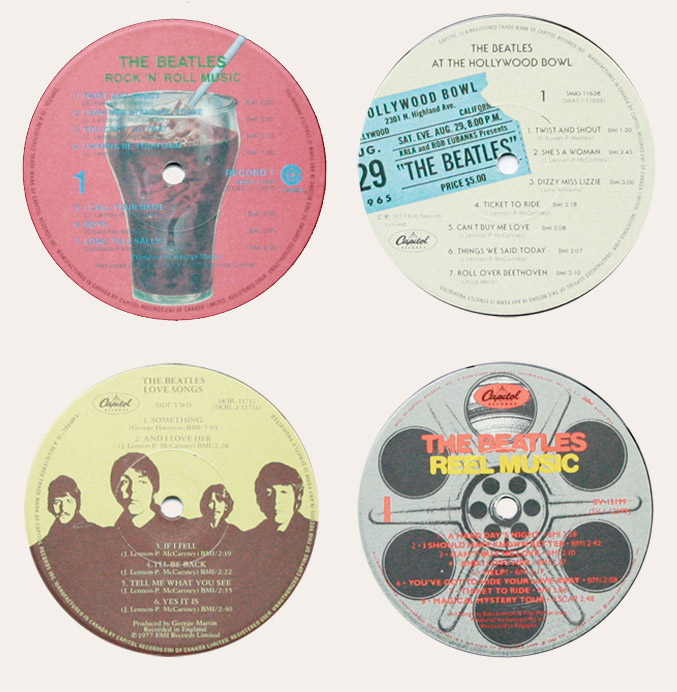
The different custom labels.
The red and blue albums also were, in a way, custom labels as three variations are color-derived versions of regular labels; they use the current label form the period they were issued in (apple, orange or purple/colored vinyl) and changed the colors to red and blue. The retro rainbow version was not customized.
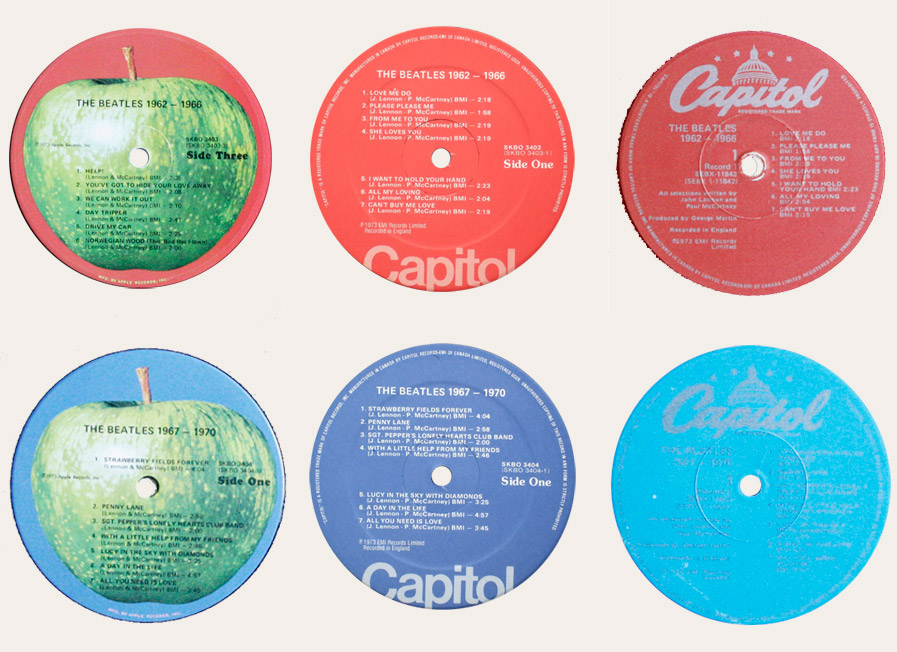
The different custom labels.
Promo
Canadian promo albums were not specially labelled, except for one early 80s sampler called Chartbusters in-store sampler.
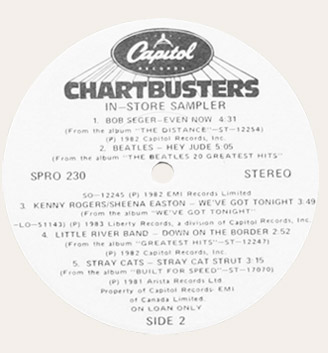
Yellow MGM
This MGM Canadian label was the old US format. The album was pressed by Quality Records and had a large circular groove similar to RCA pressings.
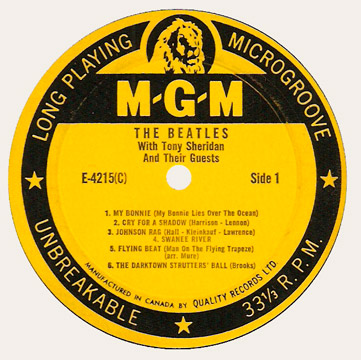
Black and Silver ATCO
This label design is the old US format and was pressed by Compo.
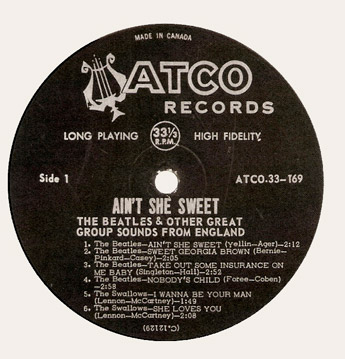
Red Polydor
Two different label variations were used for two different Beatles album, the regular label and the Polydor Special label and was pressed by Compo.
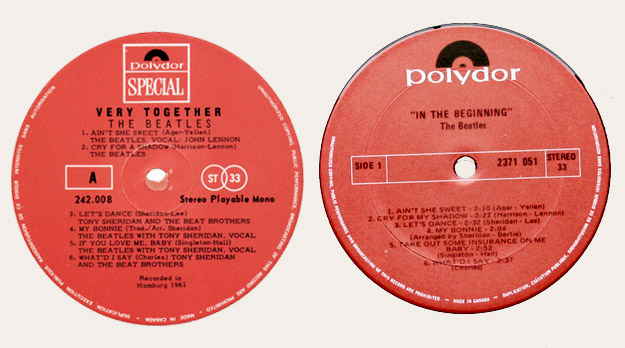
Black and White METRO
One album was issued by METRO and had their black and white label and was pressed by Quality.

45 RPM singles
Black and Silver Decca
Only one single was pressed on this label resembling the old US Decca format. No colorbands label was issued in Canada as it was in the USA. Also, beware of counterfeit singles that use the Canadian label; but instead of COMPO written in the perimeter print, we can read USA. The fake single resembles the canadian single because counterfeiters used the USA pink promo label as a template (this promo used the old Decca label - which Canada still used.
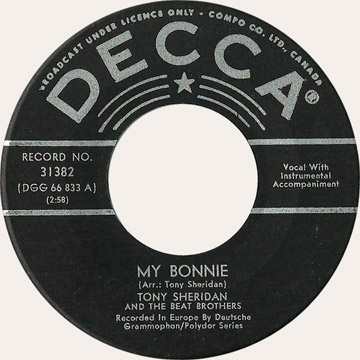
Orange / Yellow Swirl
The first label variation on which Beatles 45 rpm records were pressed was the classic orange / yellow swirl. This variation was first issued in the early sixties (72016) and has a glossy label. The perimeter print shows the word CANADA without brackets. This label variation was kept until 1966 where Capitol Records of Canada was re-incorporated to Capitol Records (Canada). Labels then had the CANADA in brackets, making it easier to differentiate early sixties pressings from late sixties repressings. This label was used for Beatles records until 1968 where they switched to their own label called Apple Reords.
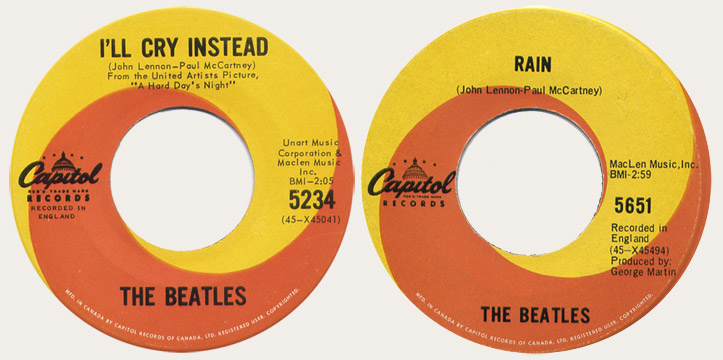
RCA pressing on the left and Compo pressing on the right.
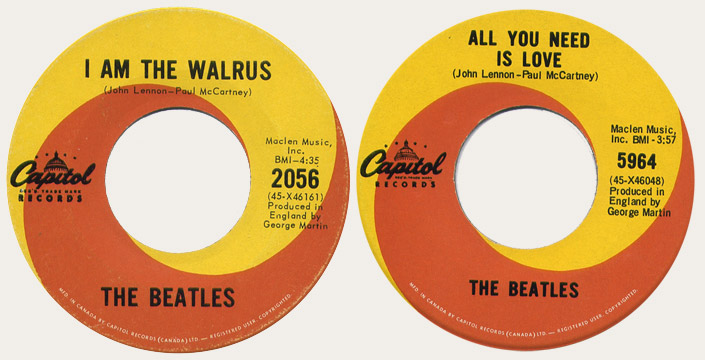
RCA pressing on the left and Compo pressing on the right.
Yellow MGM
Like the Decca label, this MGM Canadian label was the old US format. Two singles and no promos were pressed in Canada on this label.
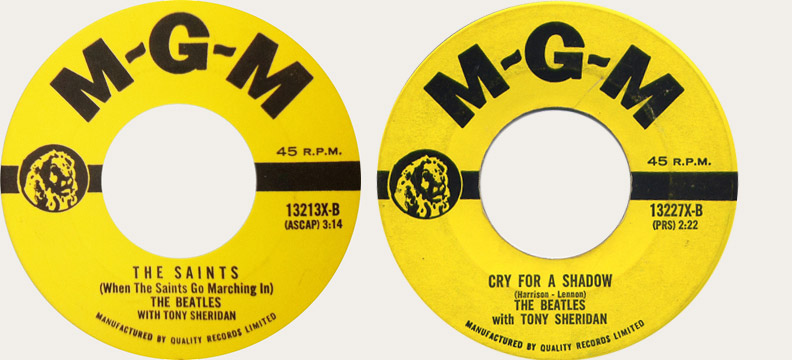
Black and Silver ATCO
Unlike the USA, only one single was pressed on this label; once again, this label design is the old US format.
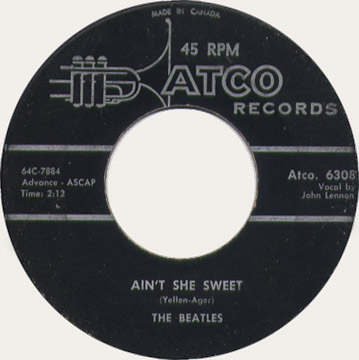
Blue Green
Only the EP "Four By The Beatles" was issued on this label in Canada.
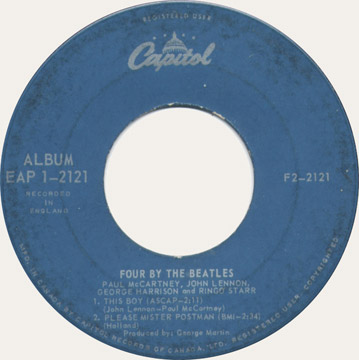
Apple
In 1968, The Beatles started their own record label called Apple Records, while still distributed by Capitol, they created their own design which showed a green apple on one side, and a sliced apple on the other side. Canadian labels are glossy with a dark green background and had "MFD by Apple Records inc" on the sliced side of the label. The sliced side of single is made sideways to have more space to write the song info, unlike US pressings that are vertical. There are no variations with different permimeter prints on Canadian pressings. Also, no pre-Apple records were reissued on the Apple label, as it was the case in the USA; instead, Capitol of Canada reissued them on the target labels. The Apple label was used for Apple releases until 1975, where the company stopped issuing records and reissues were then transfered to the orange label.
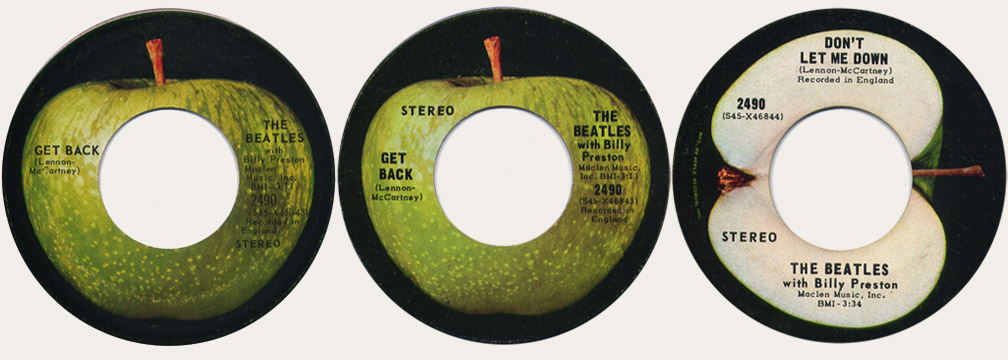
RCA pressing on the left, Compo pressing in the middle and flip side on the right.
Target with Dome Logo
The first Canadian 45 target series from 1969 were issued with the oval Capitol dome logo between February and June of 1969. These are very rare 45s as they were issued in small quantities by Compo in Cornwall when reissues were competing with NEW Beatles product and there was little demand for them.
Only Lady Madonna and Help! have been confirmed on this rare variation.
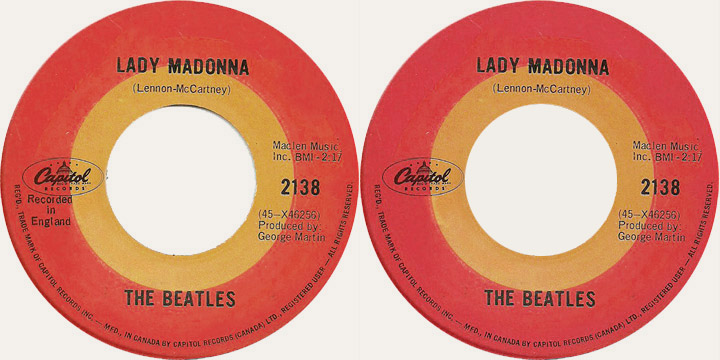
Target with Round logo
The second series of 45 issued on the target 45 label were pressed with the round target logo with a white center. No round logos with a full center has been spotted yet, unlike the US pressings. All the US format Capitol 45s have been pressed on this label in Canada. Up to now, only two Beatles singles from the 72000 series have been confirmed: Twist and Shout and All My Loving. Some of these labels were pressed on a glossy label (Compo) while others on a matte label (RCA), depending on the plant they came from. No Apple single was issued on this label.
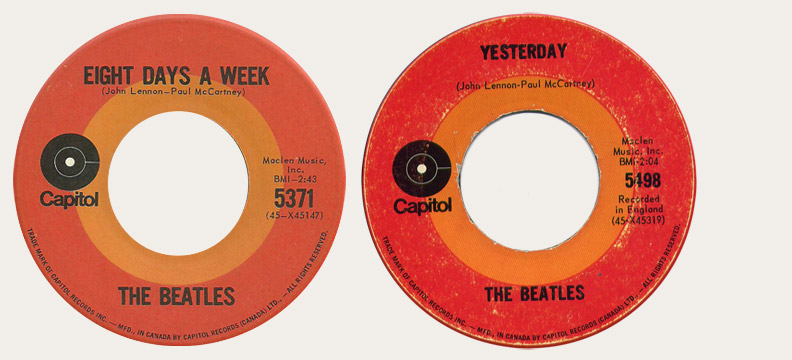
Orange
In 1972, Capitol changed labels again and this time opted for the orange label. The singles as well saw 3 different generations of this label. But each generation seems to have been pressed by one specific plant only; Compo pressed the first generation, while CBS pressed the second (to be confirmed) and Capitol the third. Source: Gilles Valiquette.
The first generation had a "gold" perimeter print that states "Capitol Records (Canada)". In 1974, Capitol changed for very similar orange labels, but with a black perimeter print that stated "Capitol Records - EMI" instead. The third generation was made by Capitol and is easily identifiable by its bumpy ridge.
Some labels had a flat finish and some were glossy; usually, first genereations are found more glossy than later generations, as all 3rd generations are flat. Capitol sold their thrid generations with a series of special sleeves called "Beatles Forever", although the sleeves ended up being used with older labels (even target labels were found in the Beatles Foerever sleeves).
All the Beatles singles were pressed on this label, from I Want To Hold Your Hand to "Julia". only three of the 72000 Beatles singles were confirmed on this label: She Loves You, All My Loving and Twist And Shout.
NOTE: The Canadian "Yes It Is / This Boy" single on the orange label was the first true stereo release of This Boy worldwide.
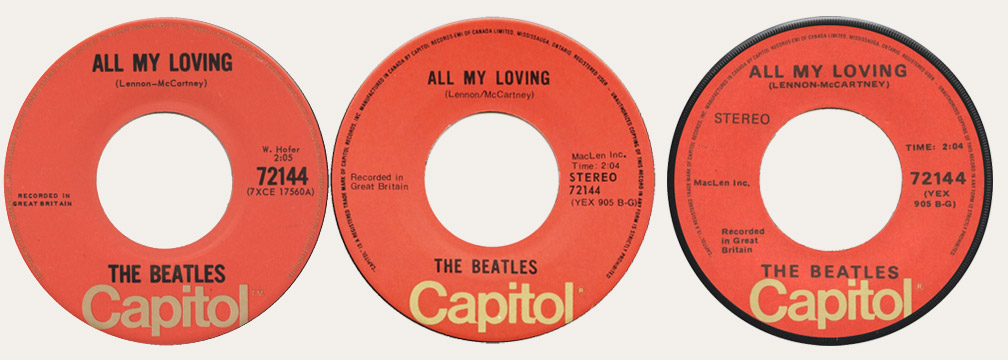
Original Gold perimeter print on the left, black print in the middle and 3rd generation Capitol pressing with bumpy ridge on the right.
Purple
In 1978, Capitol reverted to a retro look with the comeback of the purple label, featuring once again the old Capitol building logo on the label. This label is similar to the first purple 78 rpm labels. No perimeter print variations exist on this label as it is the case in the USA. All the USA format Capitol and Apple singles up until 1983 were pressed on this label. With the exception of the Sgt Pepper single from 1978, little or no Beatles singles at all were pressed on this label before 1980 as they were still selling the Beatles forever series. To date, only one Beatles single from the 72000 series is known to have been pressed on this label: Twist and Shout (72146). No others 72000 Beatles title has been confirmed yet, but it is suspected that 72144 has also been pressed as it has been reissued on the later retro rainbow label. source: Gilles Valiquette.
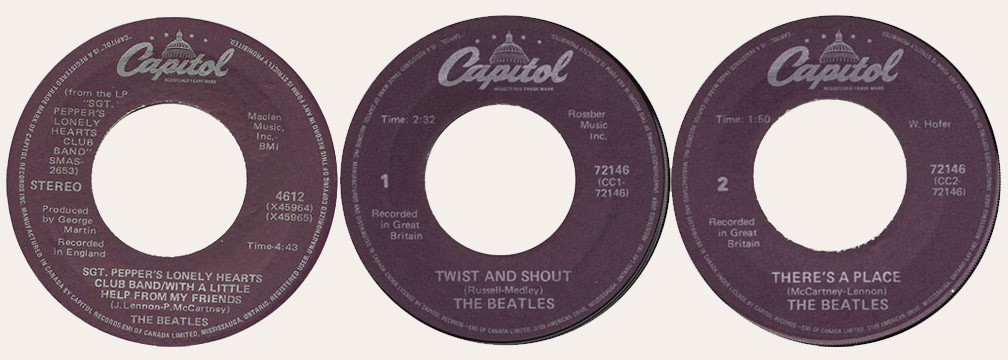
Retro Rainbow
In 1983, Capitol returned yet again to an older label type, bringing back the Black Rainbow label. This time the labels had a matte finish, and featured a white perimeter print on the black part of the label. The text on the label is silver print over the black label. Almost all the Beatles singles were pressed on this reissue label. Exceptions are: The Canadian format of Love Me Do, Do You Want To Know A Secret, Sie Liebt Dich, I'll Cry Instead, Matchbox and I Feel Fine.
All My Loving had a special picture sleeve unique to Canada. A special Canada only single was also issued on this label with a picture sleeve as part of the 72 000 series: A Hard Day's Night / Things We Said Today.
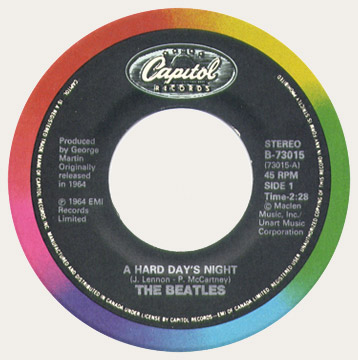
Retro Swirl
Only two single were pressed on this retro swirl label; the 20th anniversary single for Love Me Do, and the 1982 reissue single of I Want To Hold Your Hand, both pressed on conjuction with the 20 Greatest Hits Album.
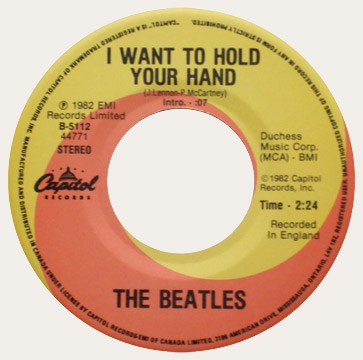
Promo
Some promo singles were pressed with a special white label, from 1967 to the 80s.

Starline
Canada issued 4 different singles on the olive green Starline label: Love Me Do, Please Please Me, Twist And Shout and Kansas City. Some later singles were pressed on the beige starline label. Three variations exist on this label: with an round target Capitol logo, with an oval dome Capitol logo and with the later 80s "star" starline logo. No blue starline was issued in Canada.
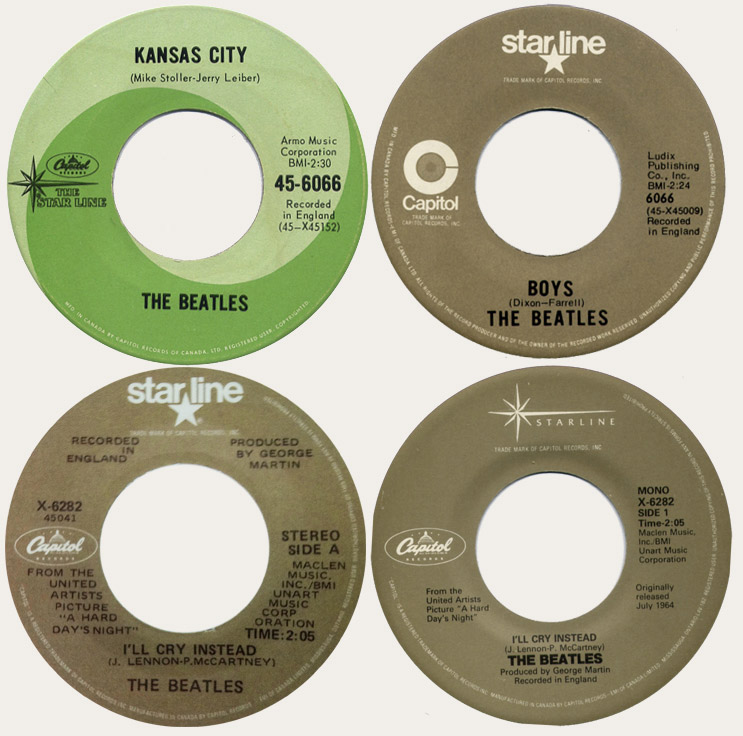
Custom
Only one single was pressed with a custom label: The Beatles Movie Medley which had a label similar to the custom album label. Singles for other custom label albums were pressed on the regular stock orange, purple or retro rainbow labels.

Copyright © 1999 - 2018
Capitol6000 & Hemmingsen Publishing
Piers A. Hemmingsen & Serge Pelletier. All Rights Reserved.